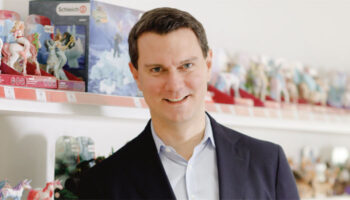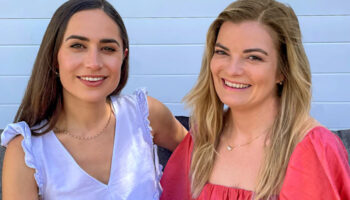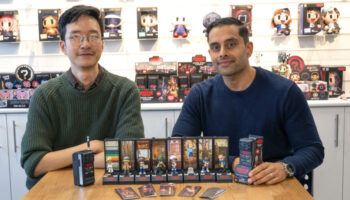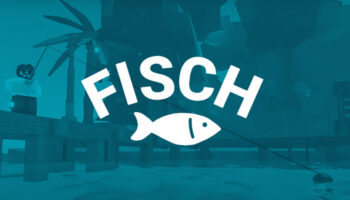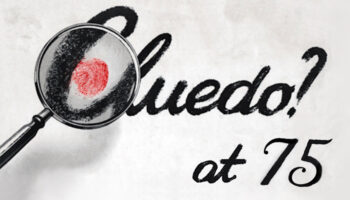“We both have a passion for play”: Industry stalwarts Brian Chapman and Brian Wilk on joining forces as inventors

Guys, it’s great to chat. Lots of our readers will be very familiar with you both from your time at Hasbro, but we’re here to discuss your new collaboration as inventors. When did your paths first cross?
Brian Wilk, Toy & Game Designer, WilkStudio: In 1999, our teams at Hasbro merged – the Rhode Island team and the Cincinnati team. We’ve worked together, in some capacity, ever since then.
Brian ‘Chappy’ Chapman, Playmaker, Chappy Hour Toys and Games: We’ve always been about creating great play experiences. Whether it was working on pre-school items with Brian, or games with Brian, or with the innovation team with Brian, we’ve always been coming up with ideas together.
Post-Hasbro, you’re now working together as inventors. Why do you feel you work well together?
Chappy: We both have a passion for play. I retired from the industry, but I couldn’t stay away… I wanted to create gaming experiences again. I thought I’d be happy doing other things but toys and games are in my blood now. Our skillsets are complimentary – we focus on different types of creation and that enhances the partnership. We’ve worked together a long time, so we know each other’s idiosyncrasies. We understand each other. It’s a good mesh of personalities and a good mesh of skillsets.
Wilk: I’m at the point in my life where this is the most exciting thing… I was an inventor before I started at Hasbro. I worked very briefly at Glass. Now I feel I’ve come full circle… I get to work and create with someone who I enjoy being around. We speak the same language, but we’re different enough that we can take ideas, build on them and make them better. We don’t always agree – and that’s a good thing – but we can move mountains together. There’s no-one else I’d rather work with than Brian.

Was there anything specific about your time at Hasbro that gave you what you needed to make that jump from in-house to being inventors?
Chappy: Well, I led the inventor relations team there for a while and I know how hard it is. It’s not just about having a great idea, it’s about timing too. You’ve got to pitch an idea in the area that a company has a focus on – otherwise they won’t invest the time. And I understand that… Companies have limited resources. You can only focus on areas that are strategic; areas they want to grow. We realise that and we know how hard it is, so we don’t get discouraged. If an idea isn’t right today, it might be right at a different time, or for a different company.
What gives us an advantage is that we can position ideas in a way that’s very strategic – a way that a large company can absorb them. We can position ideas in a way that focused on why they’re opportunities – and why they may lead to broader ranges or brands, instead of just a one-off toy or game.
Wilk: “Why” is the key word. Brian will also ask: Why? Why does this exist? Why is this special? Why now? Because we worked at a major toy and game company, we understand the process. It also means companies can feel confident about giving it to us straight! We just want to advance play and innovate as much as we can.
It must be an interesting dynamic when you pitch to current inventor relations execs, considering you’ve been in their shoes before. What makes someone good at the role of inventor relations? What do you respond well to?
Chappy: We’ve seen a lot of variety in how different inventor relations teams operate. I look at an inventor relations person not only as a conduit to the development team, but as a passionate champion for ideas they see on the outside.
A great IR person can identify things they want to get behind and push through the company. Another key attribute is that they ensure a flow of information back and forth between the development team and the inventor. That’s critical because the worst thing that can happen is a lack of communication… What is the IR person looking for? What is the status of a submitted concept? Where are they in the process? That’s critical information because as an inventor on the outside, it’s kind of a black hole if you’re not in constant communication, right?
Wilk: They need to have a vision for connecting the dots. I trust the IR person to be informed as to all the internal strategies and needs of their team, so they can do the best job to connect with us on opportunities. That then leads to what Brian said – the most important thing – communication.
Does how an IR person engage with you affect decisions around who you pitch to? Or does a company’s profile trump that kind of thing?
Chappy: No, it totally has an impact. We’ll call the people we’re closest with when we have a product innovation – and if they’re responsive, they’ll get a meeting right away. Relationships absolutely steer who you show stuff to first. Not because you love the company more, it’s just easier, right? There’s a responsiveness to those kinds of relationships that you won’t get from people that you might shoot a note to and not hear back from for weeks. And by the time they do get back to you, who knows, the item might be gone in that time. Relationships are super important.
Wilk: Invention is hard. We’re nurturing these ideas and we want them to go to people we trust. That trust is a key component to relationships – and to who we’ll call first.
Great answer. Now, what guides your approach to invention? Are you inventing exclusively together right now?
Chappy: Yes, we’re working exclusively together now that we’ve formed a collaboration. Our process is very similar to how we worked together at Hasbro. And we’re focused on the areas we have experience in. We look for simple inventions that are unique and innovative – maybe they’re inspired by a trend or something from outside of the industry – and then we add a layer of story. That story component is what’s unique about us, because it means if an invention is successful, we’ve put in place everything it needs to become a platform or an entire brand with multiple titles. It means our inventions aren’t just a one and done.
If anyone reading isn’t familiar with your time at Hasbro, what were some key launches to bear your fingerprints?
Chappy: Between us we have 17 Toy of the Year awards; there’s been so many! One that comes to mind is the recent relaunch of HeroQuest. That’s a good example of how we think. On social media, a lot of people were behind it still – people wanted a new HeroQuest experience.
Hasbro at the time wasn’t ready for a strategy game like HeroQuest, but we had HasLab – the company’s crowdfunding platform – so we said: “Let’s throw the first game into HasLab and let the consumers tell us if they want it.” We couldn’t convince Hasbro to do it otherwise! We both developed it to the point where it was ready for a crowdfunding campaign and we launched it… Within 24 hours, it had funded. The fans really wanted it.
HeroQuest is also a good example of a title that’s expandable. Hasbro has done many expansions for HeroQuest. It’s still going today and has been a big title for them. It’s a great example of how we like to do things that are a little different.

What would you point to as something underrated you worked on during your Hasbro years that you’re very proud of?
Wilk: In 2003 we came up with a game called Attacktix. That has a special spot in my heart because we did a lot of new things with it. I worked on that with Brian, Eric Nyman and Dave Kunitz. We came up with a game that was essentially ‘what if Pokémon cards came to life.’ It was a TCG in physical form, with action figures. It came out in 2005 and did really well for a while. I’m really proud of Attacktix.

Chappy: Inventing is hard, so here’s a story about a project that was hard. The product is well-known, but its journey was tough. I’m really proud to have brought Beyblade to the US. We launched that to the North American market and grew it into a billion-dollar brand for Hasbro. I was spending a lot of time in Japan developing Transformers. We came across Beyblade, working with Taraka at the time. It was exploding in Japan, so we brought it back to the US and everybody loved the play – but people thought it was too dangerous!
Oh!
Chappy: These tops were metal, they’d spin and jump out of the stadiums. Back then, they weren’t like how they are now. They were very low and the tops could shoot out of them. Our QA and safety team said: “You can’t make this; it’s too dangerous!” I was like: “What do you mean!? This is going to be the biggest thing! We have to figure out a way to do it!” It didn’t help that when we demonstrated it to the senior team, a top jumped out and hit one of our leaders – I think it was Duncan Billing! It didn’t hurt him, but the QA guy said: “See! These things are dangerous!”
Ha!
Chappy: I met with the Head of QA and Safety and said: “We’ve got to do it. Let’s figure out a way to do it.” We kept hammering away until we got to a point where we did those stadiums with the giant sides on them. We put warnings around it too and that satisfied QA. We launched it and it’s been a huge brand ever since. I mention that example because it was an outside idea, brought in through an IR type set up and we solved a lot of internal hurdles to make it happen. You have to think differently within a company to sometimes get results with ideas found outside the company.
Great picks! And what fuels creativity for you guys? What helps you have ideas?
Chappy: You have to be incredibly curious and passionate about the industry – and industries beyond. Influences are all over the place and good inventors connect them in ways never seen before. The simplest connections are the best; the no brainers that no-one has considered putting together.
The other thing is that, for Brain and I, we’re super productive when we meet in person. We meet in person at least two times a week and we’re on Teams all the time. A real energy comes when we’re side-by-side playing with toys and games. That’s where ideas are created and progressed.
Wilk: For me, it’s through collaboration. It’s exciting to bounce ideas off of someone else. We’re all being influenced by the same trends and insights; we’re all following the same breadcrumbs. We must find the next evolution of that to find something really unique and special. You connect the dots, have an ‘aha!’ moment and then work together to make it even better.
Brian and I have been in the industry for so long that we’ve done every role, from starting at the lowest level possible to leading large teams. We use all of those skills to bring an idea to life – and it’s one of the most rewarding things. And you can’t turn that off – that’s why Brian came out of retirement! We’ve got a lot of ideas left in us!
To wrap up, let’s go back to the start. What first set you on the path into toys and games?
Chappy: I had no idea that I’d ever want to be in the toy industry – but I had a passion for drawing things like cool vehicles, dinosaurs and bionic warriors for fun. I put them in my portfolio and interviewed at a company called Kenner Products in Cincinnati, Ohio. It was with Howard Bollinger, who led their inventor relations team at the time.
He said: “We need somebody to draw Batmobiles and we just got the Jurassic Park license so we need someone who can come up dinosaurs” And they did action figures and I had bionic warriors in my portfolio… So I got lucky – putting my passion into my portfolio led to a job in the toy industry.
Wilk: I’m a little different. Growing up, me and my friends all wanted to be comic book artists. In High School, we realised that we might not be good enough to do that, but my friend Dan – who goes by Attaboy – found out about the toy school at FIT. Next thing you know, we’re all there getting our start in toys.
Fantastic. And for anyone that hasn’t connected with you before, what’s the best way for them to reach out?
Chappy: We’ll be at New York Toy Fair next year, and you can email us at [email protected], or call at 401 743-9157 for any inventing enquires!
Great, thanks again guys. This has been fun!
–
To stay in the loop with the latest news, interviews and features from the world of toy and game design, sign up to our weekly newsletter here






